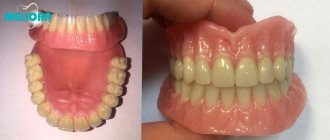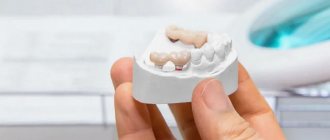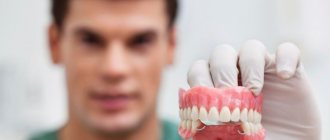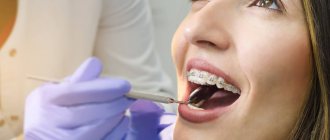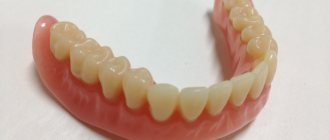Restoring chewing function by installing a prosthesis on titanium roots provides comfort for the patient and normalization of bone tissue trophism. Firmly fixed false teeth cope with the functions of natural teeth as physiologically as possible. However, implantation is not always possible. The disadvantages of the method are the presence of contraindications, complexity, price. In this case, the question arises: “What can be used instead of implants to lead a full life?” Dentistry "Dantistoff" offers alternatives to surgical methods of row reconstruction.
Why is it necessary to restore teeth?
Displacement of adjacent teeth to the site of a previously removed one.
In case of single, segmental defects of a row or complete edentia, the patient should be consulted about restoration, since the integrity of the dentition affects the health of the whole organism.
The absence of one, several or all teeth provokes:
- displacement of surviving units;
- row curvature;
- bite pathologies;
- rapid damage to remaining teeth;
- bone tissue atrophy;
- sagging gums;
- diction violations.
Due to improper load distribution, the trophism of bone tissue deteriorates and the contours of the facial skeleton change. Premature manifestation of signs of aging in the form of deformation of the oval of the face and the formation of wrinkles is possible.
Dental defects create communication problems, give rise to complexes and reduce the patient’s quality of life.
Implantation allows you to prevent all negative consequences. However, this method requires surgery and the use of expensive materials.
What are the advantages of dental inlays?
In addition to the manufacturing technology, dentures in the form of inlays differ from fillings in the following parameters:
- Firstly, they are much stronger and more durable than fillings. For example, the service life of a ceramic inlay is 20 - 25 years. Not a single filling is capable of performing its functions efficiently for such a long period. It wears out faster and needs to be replaced. If this is not done, due to a violation of its anatomical shape, the bite begins to be fixed differently, the tooth no longer chews food so effectively, the patient has to make additional efforts, which negatively affects the jaw joints, provoking their diseases.
- Secondly, dental prosthetics with ceramic inlays reliably protects the tooth from further destruction, since ceramics is a durable material that can withstand any chewing and temperature loads. This is the only option for tooth restoration that helps to avoid subsequent pulp removal and crown covering.
When implantation is not possible
| Absolute contraindications | Relative restrictions* |
| Pathologies of immunity | Pregnancy and lactation |
| Severe systemic infectious diseases | Acute viral infections |
| Malignant processes | Exacerbation of chronic pathologies |
| Autoimmune diseases | After a heart attack or stroke |
| Age up to 18 years | Dental diseases on adjacent teeth (pulpitis, caries) |
| Pathologies of bone tissue | Periodontal problems (periodontitis in the acute phase) |
| Mental disorders | Blood clotting disorders |
* These contraindications are considered relative; after adjusting the health status, it becomes possible to install an implant.
What are the pros and cons of different types of tabs?
Many patients are interested in what dental inlays are made of. Based on the material they are made of, they are divided into metal (an alloy of cobalt and chromium), ceramic, zirconium and composite. In this regard, the pros and cons of dental inlays in dentistry are different. The doctor, together with the patient, decides on the choice of design from one material or another, guided by the characteristics of each clinical case separately.
Ceramic
The best ones are E-max ceramic dental inlays, which consist of almost the same advantages. They are the most aesthetic and reliable. Their wear rate is the same as that of natural teeth. In addition, ceramic inlays have the tightest fit to the living tissues of the tooth, thus minimizing the risk of developing secondary caries. But they still have one drawback. This is quite a high price. Zirconium inlays are also a worthy choice; they are very durable, but their adhesion to tooth tissue is worse than ceramic ones.
Composite
Composite inlays made from conventional filling material are not as strong as metal, ceramic or zirconium, but they do not have the following disadvantages that are inherent in fillings made directly in the patient’s mouth.
- The composite dental inlay does not sag. If you put a large filling instead, it will not withstand the load and will tear away from living tissue, creating tension on the walls of the tooth and causing its destruction or injury. This is absolutely not typical for a composite dental inlay.
- Composite inlays do not cause problems with bite and chewing functions. They are made from individual impressions, taking into account the antagonists, that is, the adjacent teeth with which the tooth being restored comes into contact.
Metal
In our clinic, metal dental inlays are used only as a temporary option, since they often cause galvanism in patients, that is, a reaction to the influence of galvanic currents occurring in the oral cavity. This phenomenon is accompanied by a metallic taste in the mouth, a burning sensation, and increased salivation. In addition, the disadvantages of metal inlays include their poor adhesion to tooth tissues, and, as a result, their loss. Among the advantages of these restorations, one can only note their strength and hypoallergenic material. It should be noted that before the advent of ceramics, similar designs made of gold were popular - a soft metal that provided a tighter fit.
Composite inlays have a special advantage that, unfortunately, is missing from other types - they can be repaired in the oral cavity using composite filling materials, and they will continue to successfully fulfill their purpose. Therefore, composite inlays are also installed in cases where, after endodontic treatment of the tooth canals, there is no confidence that they will not have to be re-treated again. If necessary, you can always open them and carry out all the necessary manipulations. Other types of inlays cannot be repaired because the materials from which they are made do not have adhesion to the composite.
Alternative to implants
When surgery is not possible, our specialists will offer to replace the lost units with artificial teeth. Atrophic changes in the bone cannot be stopped, but you can count on temporary restoration of chewing function and smile aesthetics. Your doctor will help you choose an alternative to implantation.
Removable dentures
Removable dentures can be complete (in the absence of all teeth) and partial (in the loss of part of the teeth), and are made of hard and flexible materials.
- Lamellar. Suitable for missing all or part of teeth. Can be made of acrylic, acrylic resins, plastic. The material is hard, attached to the gums like a “suction cup” in case of complete edentia or by fixing it to adjacent teeth in case of partial edentia. The advantages of the design are an affordable price, the possibility of relocation in case of bone subsidence and repair in case of breakage. Disadvantages - unreliable fixation, mucosal injuries, chafing, instability under loads, dietary restrictions, service life 3-7 years.
- Flexible. Used for partial or complete absence of teeth. Dentures made of nylon are smaller in size, are better fixed, and rub less, but over time these qualities become disadvantages - the base stretches, and a person experiences pain when chewing hard foods. Prostheses made from Acri-Free material are considered more comfortable and durable - they are moderately flexible, elastic, do not deform, and do not cause allergies. The service life of flexible prostheses is 5-8 years.
- Bugelnye. Suitable for replacing segmental defects, they are based on a metal arch and are fixed using hooks, locks or telescopic crowns. Durable, distribute loads better. Disadvantages - accelerated wear of support units. Service life - 7-10 years.
Dental bridges
Bridges are permanent orthopedic structures that are installed in the absence of one to four teeth in a row. The method involves fixing welded artificial crowns, which are installed on ground abutment teeth on either side of the missing one. Therefore, such prosthetics are not suitable in the absence of the outermost teeth in the row (end defect) and in cases of complete edentia.
Pros: strength, resistance to stress, aesthetics. Disadvantages - just like removable dentures, they do not stop bone tissue atrophy, require proper preparation of neighboring units, and accelerate their wear.
To eliminate defects in the smile area, ceramic and zirconium bridges are used. For prosthetic restoration of molars and premolars, metal-ceramic bridges can be installed.
Combined prosthetics
For isolated defects, removable and fixed prosthetics are combined. For example, single defects are eliminated with bridges, and a removable structure is installed for segmental and disparate defects.
Mini implantation
The use of miniature implants with a diameter of up to 2.5 mm makes it possible to more firmly secure a complete removable structure. Mini implants can be installed for moderate bone deficiency. They are fixed in the gum, practically without going deep into the bone. Cost less than classic artificial roots.
The prosthesis is secured using a locking mechanism on ball-shaped abutments. You can use the patient's prosthesis, which he wore before the installation of mini-implants - add an attachment mechanism.
The method makes it possible to create conditions for more reliable fixation of a conventional removable denture, however, it cannot be called a full-fledged alternative to classical implants due to less resistance to loads and rapid wear of the locking mechanisms.
Orthodontic treatment
If there are no lateral units, the doctor may suggest eliminating the defect by moving the remaining teeth. Treatment is carried out after a thorough diagnosis and the condition of the bone tissue is satisfactory. To change the position of teeth in the defect area, braces are installed. The advantage of the method is that it does not require surgery. The downside is the presence of contraindications, it is difficult to predict the result and duration of treatment.
What is a dental inlay?
At its core, a dental inlay is a large filling. Only it is not made by a dentist in the patient’s mouth, but in a dental laboratory using individual impressions. Due to this, the design more accurately follows the shape of the cavity and fits more tightly to the tooth tissue, which minimizes the risk of caries at the junction between the inlay and the tooth.
Inlays, which are used instead of fillings, are often confused with dental cores. These are completely different designs. Let's start with the fact that a dental inlay, instead of a filling, is a restoration element of the crown part of the tooth, and a stump inlay is technical, since it serves as a support for an artificial crown when the tooth is destroyed by more than 2/3. To make it easier for patients to remember the difference, I would differentiate these prostheses as follows: the dental inlay is located outside the living tooth, and the stump inlay is located under the crown.
Which way is better
Despite the variety of modern prosthetics, implantation is considered the best way to restore lost teeth. The main advantages of the surgical method:
- the result lasts for 10 years;
- original materials and protocols are guaranteed for life;
- bone atrophy stops;
- the prosthesis on implants is securely fixed;
- the risk of complications is minimal;
- artificial teeth on implants look and feel like natural teeth.
How is a dental inlay installed?
Basically, such prostheses are installed on living teeth, since if the tooth’s nerve is removed, or there is such a need, it means that the tooth is severely damaged and to restore it, it is no longer necessary to have an inlay, but a crown. The installation of a dental inlay occurs in four stages:
- Diagnostics
. First, it is necessary to examine the patient and carry out appropriate diagnostic procedures - take X-rays and computed tomography to obtain a more objective picture of the clinical case. However, it is possible to identify the need to install an inlay and adequately assess the degree of tooth destruction only after preparing the cavity.
- Preparation
. Many patients believe that a dental inlay will require more serious tooth preparation with the removal of a large amount of its tissue. This is not true. The tooth is ground down exactly as much as necessary depending on its destruction. You should not think that the doctor will specifically “bring” the cavity to the size at which the installation of a dental inlay is indicated. In our clinic, we always use the most gentle techniques and try to preserve living tooth tissue as much as possible.
- Manufacturing
. Typically, the time it takes for structures to be ready depends on the workload of the dental laboratory, but, as a rule, the manufacturing process takes about 7 days for any type of inlay.
- Fixation
. Before installing the inlay, the tooth cavity is sandblasted to create an adhesive surface. Next, the microprosthesis is fixed in the cavity with composite cement, and the exit points of the fixing material are ground. After this, occlusal contacts are checked using articulation paper to create multi-point contact of the prosthesis with antagonist teeth.
What are the features of making dental inlays?
The inlay is made in dental laboratories using impressions of the patient’s teeth and jaws so that it matches the shape of the dental cavity as accurately as possible and ensures correct contact with other teeth without disturbing the bite. Depending on the material of the structure, a certain technology is used for its manufacture.
If we are talking about ceramic inlays, then first a porcelain frame is made by pressing, and then ceramic mass is applied to it in layers. Metal inlays are cast, and zirconium inlays are produced by digital modeling and milling using an innovative CAD/CAM system. Composite microprostheses are made from a plaster model of the tooth and are polymerized using light or heat.



